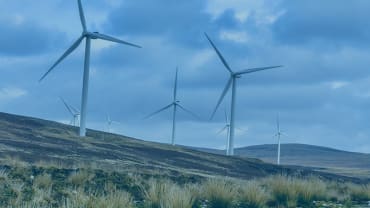Part of Glasgow City Council's Greenprint investment portfolio is a district heating network utilising heat from the Glasgow Recycling and Renewable Energy Centre at Polmadie. Ultimately this is part of a much wider strategic vision for a district heating network across the city. Will the regulation of heat networks support or frustrate this vision?
Heating our homes and buildings contributes more than 20% of Scotland's total greenhouse gas emissions. While great progress has been made in decarbonising electricity generation, decarbonising heat production remains a significant challenge.
The Committee on Climate Change (CCC) envision a future where we rely on a combination of low carbon district heat networks, heat pumps and low-carbon hydrogen to supply heat. District heat networks (DHNs) are particularly suited to cities like Glasgow where there is a higher density of heat demand. The roll out of DHNs across the UK is growing but these still make up a small proportion of the overall heat supply. Could regulation help accelerate deployment?
What is a district heat network?
A DHN is a system of insulated pipes that takes heat from a centralised source and delivers it to a number of buildings. A DHN may use a variety of heat sources, such as recovered waste, biomass, combined heat and power (CHP), gas boiler, heat pumps and renewables.
What does the Heat Networks (Scotland) Act 2021 do?
The Heat Networks (Scotland) Act 2021 (The Act) was passed unanimously by the Scottish Parliament and will come into force in stages over the next couple of years. The Act aims to regulate DHNs and the companies who operate them and to facilitate and accelerate the expansion of DHNs across Scotland. The main features include:
- Creation of a new licensing regime to ensure operators are solvent, fit and proper, and to ensure minimum standards apply across the sector;
- Strategic planning and control of DHNs through network consents, zoning (with a duty on local authorities to consider designating zones) and zone permits (effectively area based concessions) to ensure that DHNs are developed where they will have most benefit and with greater clarity on local heat demand to attract investment;
- An aim to level the playing field with other utilities by granting certain statutory rights (including necessary wayleaves) for licensed operators, helping to facilitate development; and
- Provisions to enable the transfer of heat networks from failed operators to provide a degree of protection to heat customers around continuity of supply.
For a more in depth look at the terms of the Act see our previous blogs on the bill stage below:
Key Terms from the Heat Networks (Scotland) Bill
Regulating heat networks in Scotland: a step towards decarbonisation
The Act can certainly be seen as a step in the right direction for the deployment of DHNs. It removes some barriers for developers around land rights for network infrastructure, licensing may build consumer confidence and zoning may facilitate strategic investment in DHN deployment. However, the Act is not a silver bullet and must be viewed as just one part of a wider supportive policy environment required to deliver DHNs, particularly at city scale.
What are the remaining challenges for DHN deployment?
Firstly, the Act is simply a regulatory framework with the detail to be developed through secondary legislation. There is a lot to be done and it's unlikely that we will see the first licences and consents issued before 2024.
Secondly, the Act does not provide demand surety. The creation of heat network zones may help encourage potential customers to connect and aid the promotion of DHNs but it will not be compulsory for building owners/occupiers to connect to a DHN or even to consider doing so. Complementary measures will be needed to incentivise potential customers to connect to a DHN and drive the demand which will unlock the investment required to deliver large scale DHNs.
Finally, the Act does not include specific consumer protections as the Scottish Parliament does not have devolved powers to make laws in this area. It is expected that this gap will be filled by UK legislation introducing consumer protections for heat customers which may boost consumer confidence.
City wide heat networks in Glasgow?
According to the CCC, to be economically viable, DHN schemes need a high density of heat demand, making them suited to urban areas. Generating heat at scale for multiple properties through a DHN can be more efficient than using gas boilers or heat pumps within individual homes. This means that DHNs are especially well-suited to urban environments with dense populations.
DHNs could play a vital role in cities like Glasgow where there is a high demand for heat and the scale of the opportunity is clear. The Act will play a part in supporting the investment required. A strategic city wide DHN in Glasgow could become a reality if policy makers, heat operators, investors and developers all commit to support and deliver that common goal.
Contributors
Partner
Senior Solicitor













